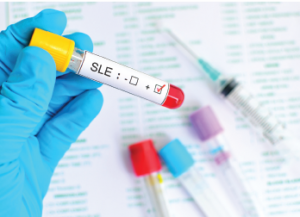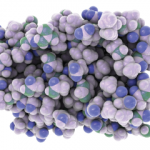
Jarun Ontakrai / SHUTTERSTOCK.COM
SAN DIEGO—What are the predisposing genes that suggest who will develop active systemic lupus erythematosus and who will stay healthy? Decades of research data help rheumatologists clarify this picture, says Argyrios N. Theofilopoulos, MD, professor of immunology and microbiology at Scripps Research Institute in La Jolla, Calif. At his Nov. 5 lecture at the 2017 ACR/ARHP Annual Meeting, Dr. Theofilopoulos shared findings from his 45 years of research into the pathogenesis of lupus supported by the National Institute of Arthritis and Musculoskeletal and Skin Diseases (NIAMS).
“We define predisposing genes as allelic or mutated variances that lead to the gain or loss of function, and we attempt to identify these genes using intercrosses between resistant and susceptible strains of mice, and develop chromosomal maps based on single-nucleotide polymorphisms (SNPs),” said Dr. Theofilopoulos. “Because our approach is moving from phenotype to genotype, it’s unencumbered by preconceived notions, and thus, provides the opportunity to identify novel genetic contributions in this disease.”
Heterogeneous Disease
Lupus is a highly heterogeneous disease, but there are common denominators in its complex processes, said Dr. Theofilopoulos.

Dr. Theofilopoulos
“Because this disease is mediated not only by genetic predisposition but also by environmental contributions, and because it is polygenic, it’s been very difficult to identify the predisposing and effector genes in humans,” so researchers use certain strains of mice that develop a similar form of lupus, he said. Lupus researchers long focused on addressing problems within the adaptive immune system and looked for pathogenic effectors that would trigger the production of pro-inflammatory cytokines.1 “We determined the tolerance processes, defects in T and B cells, and the presence of genes that promoted or even inhibited the disease process. Despite these advances, several questions remained unanswered. What triggers this disease? Why is there such a diversity of autoantibodies? What is the essential process by which inflammatory responses are initiated?”
Around 20 years ago, lupus research shifted to defining the molecular basis and composition of the innate immune system, particularly receptors that facilitate the recognition of nucleic acids inside cells, rather than just receptors on cell surfaces, he said. The endolysosomal nucleic acid-sensing Toll-like receptors (TLRs) 3, 7, 8 and 9 are of particular interest in lupus, as well as cytosolic sensors like the RNA-recognizing RIG-I and MDA-5, and DNA-sensing c-GAS and AIM2. These sensors induce various transcriptional factors and promote the production of pro-
inflammatory cytokines like type 1 interferon, and interleukin (IL) 1 and IL-18.
Type 1 Interferons
Type 1 interferons play a role in lupus pathogenesis, because increased levels of IFN-α are found in the serum of SLE patients.2 Complexes of immunoglobulin G (IgG) and nucleic acids stimulate interferon production by plasmacytoid dendritic cells (pDCs) and B cell activation, he said. IFN-α in lupus serum promotes monocyte maturation to dendritic cells, and there is an interferon-induced gene expression signature in the peripheral blood and affected tissues in lupus patients. Patients with malignancies or viral infections who are treated with IFN-α sometimes develop lupus-like symptoms, he said.
In a 2003 study, predisposed NZB mice were bred to lack the common receptor for type 1 interferons.3 These IFNAR-knockout NZB mice had lower mortality and profoundly reduced signs of lupus-like disease, such as anti-erythrocyte and anti-DNA autoantibodies, compared with wild-type mice, he said. In a 2012 study, NZB mice were bred to lack IFN-β to see if either it or any of the 13 IFN-α proteins mediated lupus-like disease.4 The results showed that mice with deleted IFN-β did develop disease.
“This suggests that the pathogenic effect of interferons is primarily mediated by the alpha types. Then, we set out to find if such a treatment would have any clinical relevance,” he said. In the 2012 study, researchers developed an antibody against the common receptor for type 1 interferon, called IFNAR, to treat the mice affected with lupus-like disease. The results were positive: antinuclear antibodies, anti-chromatins, kidney deposits and mononuclear cells were reduced, and the mice lived longer. “However, this treatment was initiated early in the disease process, around 12 weeks of age. If treatment was delayed to beyond 18 weeks of age, the protective effects were significantly minimized. This indicates that the role of type 1 interferons and pDCs is very likely exercised at the early stages of the disease. If we can translate these findings to the clinic, then treatment with anti-IFNAR should be complemented with additional treatments that interfere with the adaptive immune system.”
Toll-Like Receptors
To understand the role of the nucleic acid-sensing, endosomal TLRs 3, 7, 8 and 9 in lupus, researchers created mice with new, mutant version of the molecule UNC93B1 called 3d.5 Normally, this molecule binds to endosomal TLRs in the endoplasmic reticulum and then transports them into the endolysosomes, said Dr. Theofilopoulos. Mice with the UNC93B1 mutation had no signaling of endosomal TLRs, and disease characteristics were profoundly reduced in the mice that carried a duplication of TLR-7, he said. Later research showed that mice with this UNC93B1 3d mutation are protected from developing lupus-like disease, and the mutation seems to broadly reduce lupus autoantibodies like anti-cardiolipin, anti-β2 glycoprotein and anti-MPO, he said.6
“It seems that engagement of the endosomal, nucleic-acid sensing TLRs, affects not only the classical anti-chromatin and anti-DNA antibodies in lupus, but also the vast majority of the broad spectrum of autoantibodies seen in lupus,” said Dr. Theofilopoulos. “The question perplexing many investigators is that we did not know why there was such a diversity. It seems that it’s all based on the recognition of nucleic acids.”
More mutant mice were bred to examine the role of pDCs in lupus pathogenesis including one with a deletion of the IRF-8 gene, an interferon-inducible protein with profound effects on the innate and adaptive immune responses. Mice without the IRF-8 gene had reduced pDCs and disease.7 Still, IRF-8 deletion also affected development of other dendritic cells too, so the role of pDCs was still unclear. To clarify it, researchers used other mutations, including a nonfunctional form of SLC15A4 (a histidine/peptide transporter), which interferes with the production of type 1 interferons and proinflammatory cytokines by pDCs. When the SLC15A4 molecule is mutated, there is no signaling by the endosomal TLRs and mice exhibit reduced disease, he said.
“The exact function of SLC15a4 has not been fully defined. It seems that it’s not only expressed on pDCs, but also on B cells and dendritic cells,” he said. “On the basis of all of these findings, we hypothesize that lupus proceeds in two phases.
“The first phase is the uptake of nucleic acids or microparticles, in particular pDCs and perhaps DCs, the production of type 1 interferons, upregulation of major histocompatibility class II molecules, self-peptide presentation and engagement of T cells and B cells bearing proper receptors.
“This leads to the production of autoantibodies and immune complexes, which is the second or amplification phase, where such immune complexes are secondarily taken up by pDCs, DCs and B cells, and thus, perpetuate and propagate the disease process.”8
Pathogenic Effects
Questions about the role of TLRs and interferons in lupus remain unanswered. Are all TLRs equally pathogenic, and are all these pathogenic effects mediated by type 1 interferons?
“Also, what are the mechanisms by which we normally avoid the engagement of our own nucleic acid-sensing TLRs, and how are these processes subverted?” asked Dr. Theofilopoulos. The role of cytosolic nucleic acid sensors, such as RIG-I and MDA-5, compared with TLR sensors is still unclear. “And finally, how will all of these studies lead to the development of novel therapies for lupus and other diseases?”
Although all the endosomal TLRs are trafficked by UNC93B1, notable differences exist, he said. TLR 7 seems to be more pathogenic than the others, possibly due to increased signaling, and evidence shows that TLR 8 and 9 may be protective.
“How do we avoid recognition of self-nucleic acids? Is it really complete avoidance of recognition by a normal individual, or perhaps there is some recognition of a low grade that may be important for the priming of the immune system. We do not know,” he said. “But the absence of disease-promoting recognition is thought to be due to the intracellular sequestration of these nucleic acid sensors, effects of nucleases, and other processes.”
“In autoimmunity, there may be an oversupply of self-nucleic acids due to increased apoptosis, necrosis or NETosis. There may be defective clearance, such as defects in scavenger receptors that remove apoptotic or necrotic materials, as well. If these processes don’t work properly, autoimmunity could be the result,” he said.
“So there are processes whereby we may avoid recognition, and there are circumstances where these barriers are broken, and then autoimmune disease might be the consequence,” he said. Cytosolic sensors may play a role too, because specific mutations of RIG-I or MDA-5 (IFIH1), and defects in nucleases like TREX-1 and RNASEH2, and certain signaling molecules (STING) promote development of syndromes called interferonopathies.
“These diseases are very peculiar. They’re not necessarily lupus, although occasionally, but very rarely, classical lupus patients may have mutations in the genes that induce these interferonopathies,” he said. “Only about 500 families in the world have been identified that have the TREX1 mutation for Aicardi Goutieres syndrome or chilblain lupus.
“Thus, lupus and autoinflammatory syndromes have stimulated efforts to develop targeted therapies, and clinical trials have been initiated, including IFNAR antibody (anifrolumab), IFN-Kinoid, anti-TLR7, bortezomib and JAK-kinase inhibitors. Inhibitors of SLC15A4 may also be considered.”
Research in these areas is ongoing at his laboratory, he added.
Susan Bernstein is a freelance journalist based in Atlanta.
References
- Theofilopoulos AN, Gonzalez-Quintial R, Lawson BR, et al. Sensors of the innate immune system: Their link to rheumatic diseases. Nat Rev Rheumatol. 2010 Mar;6(3):146–156.
- Crow MK. Type I interferon in the pathogenesis of lupus. J Immunol. 2014 Jun;192(12):5459–5468.
- Santiago-Raber ML, Baccala R, Haraldsson KM, et al. Type-1 interferon receptor deficiency reduces lupus-like disease in NZB mice. J Exp Med. 2003 Mar;197(6):777.
- Baccala R, Gonzalez-Quintial R, Schreiber RD, et al. Anti-IFN-αβ receptor antibody treatment ameliorates disease in lupus-predisposed mice. J Immunol. 2012;189:5976–5984.
- Tabeta K, Hoebe K, Janssen EM, et al. The UNC93B1 mutation 3d disrupts exogenous antigen presentation and signaling via toll-like receptors 3, 7 and 9. Nat Immunol. 2006 Jan;7:156–164.
- Koh YT, Scatizzi JC, Gahad JD, et al. Role of nucleic-acid sensing TLRs in diverse autoantibody specificities and antinuclear antibody-producing B cells. J Immunol. 2013 May;190(10):4982–4990.
- Baccala R, Gonzalez-Quintial R, Blasius AL, et al. Essential requirement for IRF8 and SLC15a4 indicates plasmacytoid dendritic cells in the pathogenesis of lupus. PNAS. 2013 Feb;110(8):2940–2945.
- Theofilopoulos AN, Kono DH, Baccala R. The multiple pathways to autoimmunity. Nat Immunol. 2017;18:716–724.


